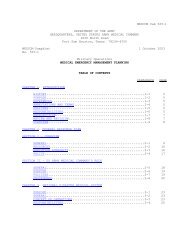(MCD) Guidelines
(MCD) Guidelines
(MCD) Guidelines
You also want an ePaper? Increase the reach of your titles
YUMPU automatically turns print PDFs into web optimized ePapers that Google loves.
<strong>Guidelines</strong> for Military Mass Casualty Decontamination Operations<br />
During a Domestic HAZMAT/Weapon of Mass Destruction Incident<br />
o Cut a hole in the top, big enough for a head, and arm holes on the side.<br />
o This bag can be used as covering if no other shelter is available.<br />
o A Tyvek-type covering could be used as a gown instead of a trash bag.<br />
Bags of personal effects, once identified, closed, and secured, can be placed into<br />
large trash cans, large plastic-lined cardboard boxes, 58 or barrels to keep them all<br />
together.<br />
Some personal effects, such as eyeglasses, hearing aids, walkers, or prosthetic<br />
limbs, may be critical for the casualty to be able to function independently. However,<br />
such personal effects may be made of porous materials or have numerous crevices<br />
that could easily trap contamination. Try to decontaminate the item while the<br />
casualty is assisted through the mass decontamination line. Submerse the item into<br />
a proper decontaminant if it will not be damaged or destroyed in the process. Have<br />
proper monitoring equipment available to verify that the item is thoroughly<br />
decontaminated before it is released back to the casualty. The return of such items<br />
should be made on a case-by-case basis and done with the approval of a higher<br />
authority. Any contact lenses should be removed, discarded, and not reinserted.<br />
8.1.9. Triage<br />
INTENT: Sort casualties into groups for decontamination and treatment based on<br />
their presenting conditions.<br />
Triage is a prioritization system to allow responders to<br />
provide the necessary care to as many people as<br />
possible. Do not confuse decontamination triage with<br />
medical triage. Decontamination triage is performed to<br />
determine who should be washed off first. Medical triage<br />
is performed to determine who should receive medical<br />
treatment first.<br />
Triage should be conducted repeatedly throughout the<br />
<strong>MCD</strong> process because a casualty’s status could change.<br />
Some response agencies may perform gross<br />
decontamination on all casualties as rapidly as possible<br />
without performing any triage. However, if<br />
decontamination triage is performed, casualties should<br />
be separated into these categories:<br />
1. Ambulatory and symptomatic<br />
2. Nonambulatory<br />
3. Ambulatory, non-symptomatic, exposed to contaminant<br />
4. Ambulatory, non-symptomatic, no obvious exposure to contaminant<br />
<strong>MCD</strong> Principles<br />
for Triage<br />
DHS UTL Tasks<br />
• ResB2b 6.1 and 6.2<br />
• ResC1a 5.1, 6.1, 6.2,<br />
6.2.1, 6.2.2, 6.2.3, and<br />
6.3<br />
USACBRNS Tasks<br />
• 03-2-5124 Step 3<br />
• 03-2-5126 Step 5<br />
• 03-2-6593 Step 2<br />
The highest priority for decontamination is ambulatory casualties who are<br />
symptomatic yet can follow simple directions. They are easiest to decontaminate<br />
40 Original



